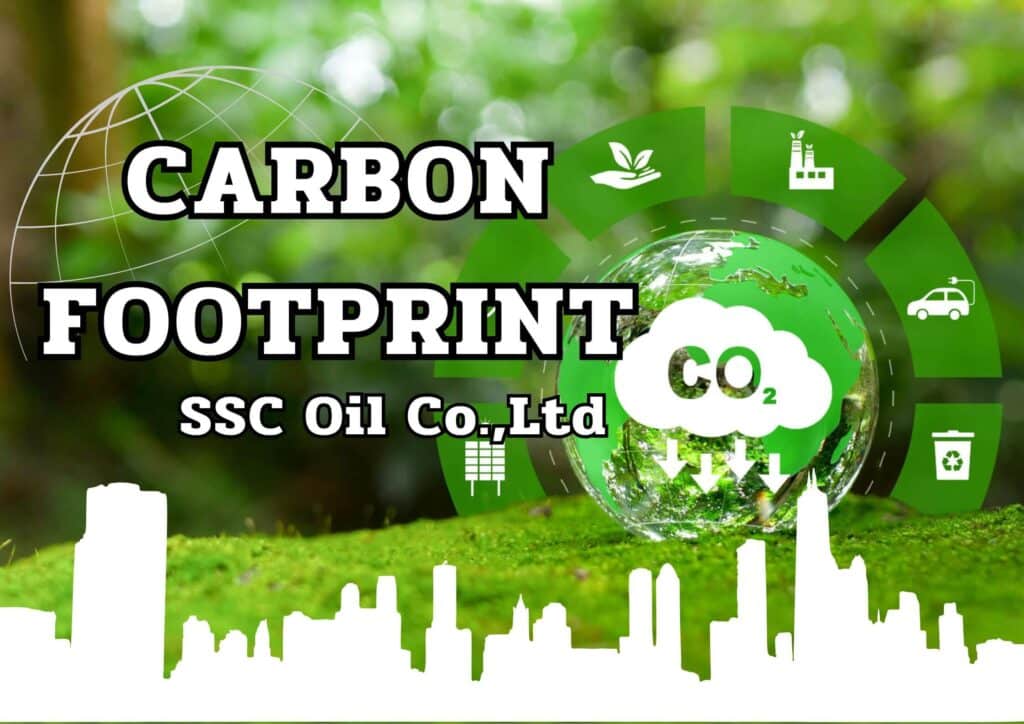
What is Carbon Footprint?
Carbon Footprint is an indicator to evaluate the amount of greenhouse gases emitted from various activities within the organization, both directly and indirectly. throughout the life cycle of a product or service Since the acquisition of raw materials Production process, use, and disposal of product remains after their useful life has expired. It will be calculated in the form of carbon dioxide equivalent (CO2e).
Seeking professional waste management solutions for the disposal of industrial waste, oils, and sludges?
Call 020266547 Inquire via Line: @SSCOILHow many types of Carbon Footprint are there?
By definition it is called “Carbon Footprint” which can be divided into 2 types namely
1. Carbon Footprint of Organization or CFO
Refers to the amount of greenhouse gases emitted from related activities within an organization or department, both directly and indirectly. that cause environmental impacts such as electricity use, waste management, transportation, and fuel use within the organization By showing the results in terms of quantity. or kilograms of carbon dioxide equivalent (CO2e) for an organization's Carbon Footprint can be divided into 3 main parts:
1.1 Scope 1 Refers to direct greenhouse gas emissions from the organization's activities.
such as the combustion of fuel in the production process Methane emissions from production processes
1.2 Scope 2 Refers to greenhouse gas emissions from the use of electricity and heat purchased from outside.
For example, carbon dioxide emissions from fuel combustion in power plants. Thermal energy and steam energy Purchasing electricity from the Electricity Generating Authority for use within the organization
1.3 Scope 3 Refers to greenhouse gas emissions from other activities of the organization that are not included in Scope 1 and Scope 2.
such as transportation of goods employee transportation waste disposal
2. Carbon Footprint of Product or CFP
Refers to the total amount of greenhouse gases emitted throughout the product's life cycle. Since the acquisition of raw materials The production process, transportation, use, and disposal of product remains after their useful life has expired. Normally, the Carbon Footprint of a product varies according to the type of product and production method. For example, products made from natural raw materials, such as clothing made from cotton, tend to have a lower carbon footprint than products made from synthetic raw materials, such as clothing made from plastic. or in the production process Products produced using clean energy, such as energy from the sun, which is used through receiving light from solar panels and converting it into electrical energy for use within the production process, will have a lower Carbon Footprint than the product. Produced using fossil energy (coal)
Benefits of doing What is Carbon Footprint?
1. The organization knows the amount of greenhouse gas emissions that the organization produces, including measuring the Carbon Footprint. It helps the organization know the amount of greenhouse gases that are generated from various activities of the organization. It allows the organization to identify the source of greenhouse gas emissions. mirror and find ways to manage activities that affect the environment
2. Carbon Footprint data can be used to inform planning decisions. Management guidelines and increase efficiency To reduce the amount of greenhouse gas emissions Helps reduce costs in energy, resources and makes business operations sustainable.
3. Promote products with low levels of greenhouse gas emissions. By promoting the education of consumers about the environmental impacts of products.
4.Marketing benefits Consumers themselves are starting to turn their attention to products and services that have a low Carbon Footprint calculated. Announcements about reducing Carbon Footprint can make the market more attractive and acceptable.
The importance of Carbon Footprint To the organization
The organization recognizes the importance of creating a Carbon Footprint to meet needs and readiness to enter the carbon credit market. To compete in trade in the future, in the future Carbon Footprint will be an important tool in solving global warming problems. The problem of climate change (Climate Change) also helps the organization to see an overall picture of the amount of greenhouse gas emissions that occur from various activities. within the organization, which will help identify the main sources of greenhouse gas emissions and effectively set greenhouse gas emissions reduction targets. Save money Reduce costs in terms of energy use Resource use and material use, etc.
If you have any questions about Carbon Footprint, you can contact SSC Oil Company Limited. We are happy to serve you. Give advice on Carbon Footprint. If you use our services It also helps reduce Carbon emissions.
phone. (+66) 2-026-6547
Email: sscoil002@gmail.com




